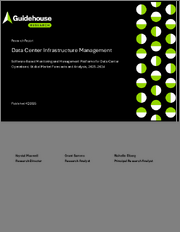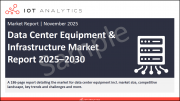
|
시장보고서
상품코드
1675453
세계의 데이터센터 시장 : 컴포넌트별, 유형별, 기업 규모별, 최종사용자별, 지역별(2025-2033년)Data Center Market Report by Component, Type, Enterprise Size, End User, and Region 2025-2033 |
||||||
데이터센터 시장 세계 시장 규모는 2024년 2,136억 달러에 달했습니다. 향후 IMARC Group은 2033년까지 4,945억 달러에 달하고, 2025년부터 2033년까지 9.29%의 연평균 성장률(CAGR)을 나타낼 것으로 예상하고 있습니다. 클라우드 서비스, 데이터 스토리지 솔루션, 엣지 컴퓨팅에 대한 시장 수요가 성장의 주요 요인입니다. 또한, 시장 예측은 디지털 전환의 확대, IoT 도입, 에너지 효율적이고 지속 가능한 데이터센터 인프라의 세계 확대에 힘입어 지속적인 성장세를 보일 것으로 전망하고 있습니다.
데이터센터는 대량의 데이터와 디지털 정보를 저장, 처리, 관리하기 위한 안전하고 신뢰할 수 있는 환경을 제공하기 위한 시설입니다. 데이터센터는 서버, 스토리지 시스템, 네트워크 장비, 기타 하드웨어 및 소프트웨어 컴포넌트 등 기업이 IT 인프라를 중앙집중적으로 보관 및 관리하는 곳입니다. 데이터센터는 대규모의 복잡한 인프라로, 정전 등의 장애가 발생하더라도 장비가 계속 가동될 수 있도록 이중화된 전원 및 냉각 시스템을 갖추고 있습니다. 또한, 물리적 및 사이버 위협으로부터 보호하기 위한 고도의 보안 대책도 마련되어 있습니다. 데이터센터는 현대의 다양한 비즈니스와 조직, 특히 디지털 데이터와 용도에 의존하는 조직의 기능에 필수적입니다. 따라서 금융, 의료, 전자상거래, 미디어 등 다양한 산업에서 데이터센터를 채택하고 있습니다.
데이터센터 시장 동향 :
급속한 디지털화, 기업 및 소비자에 의해 생성되는 디지털 데이터의 폭발적인 증가, 전자상거래 데이터베이스의 중요성 증가가 시장 성장을 가속하는 주요 요인으로 작용하고 있습니다. 이 외에도 클라우드 컴퓨팅 서비스 및 빅데이터 분석의 채택이 증가하고 있으며, 이를 지원하기 위해 대규모 데이터센터 인프라가 필요하다는 점도 시장 성장에 긍정적인 영향을 미치고 있습니다. 또한, 광범위한 장치와 센서를 인터넷에 연결하는 사물인터넷(IoT)의 적용이 확대되고 엣지 컴퓨팅에 대한 요구가 증가함에 따라 보다 분산된 데이터센터 인프라의 필요성이 증대되고 있습니다. 이와 함께 다양한 산업 분야에서 인공지능(AI)과 머신러닝(ML)의 도입이 확대되면서 저지연, 고성능 컴퓨팅에 대한 수요가 확대되고 있는 것도 이 시장의 성장에 도움이 될 것으로 보입니다. 이와 더불어, 하이퍼컨버지드 인프라 및 소프트웨어 정의 데이터센터의 등장, 데이터센터 리소스를 효율적이고 유연하게 관리할 수 있는 혁신적인 기술의 채택 등 현재 진행 중인 발전이 시장 확대에 기여하고 있습니다. 이와 함께, 기업들이 데이터센터 공간을 임대하여 서버와 장비를 수용하는 코로케이션 서비스의 채택이 증가하고 있는 것도 큰 성장 촉진요인으로 작용하고 있습니다. 또한, 동영상 스트리밍 서비스의 성장, 휴대폰, 태블릿, 노트북 등 스마트 컨슈머 디바이스의 보급, 5세대(5G) 네트워크의 확대는 시장 전망을 밝게 하고 있습니다.
본 보고서에서 다룬 주요 질문
- 세계 데이터센터 시장은 지금까지 어떻게 변화해왔고, 앞으로 어떻게 변화할 것인가?
- 세계 데이터센터 시장 성장 촉진요인, 억제요인, 기회요인은 무엇인가?
- 각 촉진요인, 억제요인, 기회가 세계 데이터센터 시장에 미치는 영향은?
- 주요 지역 시장은?
- 가장 매력적인 데이터센터 시장은 어느 국가인가?
- 구성요소별 시장 분석은?
- 데이터센터 시장에서 가장 매력적인 구성 요소는 무엇인가?
- 유형별 시장 분석은?
- 데이터센터 시장에서 가장 매력적인 유형은?
- 기업 규모별 시장 현황은?
- 데이터센터 시장에서 가장 매력적인 기업 규모는?
- 최종사용자별 시장 분석은?
- 데이터센터 시장에서 가장 매력적인 최종 사용자는?
- 시장 경쟁 구도는?
- 세계 데이터센터 시장의 주요 기업은?
목차
제1장 서문
제2장 조사 범위와 조사 방법
- 조사 목적
- 이해관계자
- 데이터 소스
- 1차 정보
- 2차 정보
- 시장 추정
- 보텀업 접근
- 톱다운 접근
- 조사 방법
제3장 주요 요약
제4장 서론
- 개요
- 주요 업계 동향
제5장 세계의 데이터센터 시장
- 시장 개요
- 시장 실적
- COVID-19의 영향
- 시장 예측
제6장 시장 분석 : 구성요소별
- 솔루션
- 서비스
제7장 시장 분석 : 유형별
- 코로케이션
- 하이퍼스케일
- 엣지
- 기타
제8장 시장 분석 : 기업 규모별
- 대기업
- 중소기업
제9장 시장 분석 : 최종사용자별
- 은행, 금융 서비스 및 보험(BFSI)
- IT 및 통신
- 정부
- 에너지 및 유틸리티
- 기타
제10장 시장 분석 : 지역별
- 북미
- 미국
- 캐나다
- 아시아태평양
- 중국
- 일본
- 인도
- 한국
- 호주
- 인도네시아
- 기타
- 유럽
- 독일
- 프랑스
- 영국
- 이탈리아
- 스페인
- 러시아
- 기타
- 라틴아메리카
- 브라질
- 멕시코
- 기타
- 중동 및 아프리카
- 시장 내역 : 국가별
제11장 촉진요인 및 억제요인·기회
- 개요
- 성장 촉진요인
- 성장 억제요인
- 기회
제12장 밸류체인 분석
제13장 Porter의 Five Forces 분석
- 개요
- 바이어의 교섭력
- 공급 기업의 교섭력
- 경쟁 정도
- 신규 진출업체의 위협
- 대체품의 위협
제14장 가격 분석
제15장 경쟁 구도
- 시장 구조
- 주요 기업
- 주요 기업 개요
- Amazon Web Services Inc.(Amazon.com Inc.)
- Cisco Systems Inc.
- Dell Inc.(Dell Technologies Inc.)
- Digital Realty Trust Inc.
- DXC Technology Company
- Equinix Inc.
- Google LLC(Alphabet Inc.)
- Hewlett Packard Enterprise Development LP
- International Business Machines Corporation
- Microsoft Corporation
- NTT Communications Corporation(Nippon Telegraph and Telephone Corporation)
- Oracle Corporation
The global data center market size reached USD 213.6 Billion in 2024. Looking forward, IMARC Group expects the market to reach USD 494.5 Billion by 2033, exhibiting a growth rate (CAGR) of 9.29% during 2025-2033. The market demand for cloud services, data storage solutions, and edge computing is the primary driver of growth. Moreover, the market forecast indicates constant growth, supported by amplifying digital transformation, IoT adoption, and the expansion of energy-efficient and sustainable data center infrastructure globally.
A data center is a facility used to provide a secure and reliable environment for storage, processing, and managing large amounts of data and digital information. It is a centralized location for organizations to store and manage their IT infrastructure, such as servers, storage systems, networking equipment, and other hardware and software components. A data center is a large, complex infrastructure with redundant power and cooling systems to ensure the equipment remains operational even during power outages or other disruptions. In addition to this, it has sophisticated security measures in place to protect against physical and cyber threats. A data center is critical to the functioning of various modern businesses and organizations, particularly those that rely on digital data and applications. As a result, it is employed by a wide range of industries, including finance, healthcare, e-commerce, and media.
Data Center Market Trends:
Rapid digitalization, the exponentially growing volume of digital data generated by businesses and consumers, and the rising importance of e-commerce databases are prime factors driving the market growth. Besides this, the increasing adoption of cloud computing services and big data analytics that require significant data center infrastructure to support their operations is positively impacting the market growth. Moreover, the expanding application of the Internet of Things (IoT), which involves connecting a wide range of devices and sensors to the Internet, and the escalating need for edge computing is propelling the need for more distributed data center infrastructure. In line with this, the increasing adoption of artificial intelligence (AI) and machine learning (ML) across various industrial verticals and the large-scale demand for low latency and high-performance computing are presenting remunerative growth opportunities for the market. In addition to this, ongoing advancements, such as the advent of hyper-converged infrastructure and software-defined data centers and the employment of innovative technologies that allow efficient and flexible management of data center resources, are aiding in market expansion. Concurrent with this, the rising adoption of colocation services, where businesses rent space in data centers to house their own servers and equipment, is acting as another significant growth-inducing factor. Furthermore, the bolstering growth of video streaming services, the proliferation of smart consumer devices such as phones, tablets, and laptops, and the expansion of fifth-generation (5G) networks are creating a favorable outlook for the market.
Key Market Segmentation:
Component Insights:
- Solution
- Services
Type Insights:
- Colocation
- Hyperscale
- Edge
- Others
Enterprise Size Insights:
- Large Enterprises
- Small and Medium Enterprises
End User Insights:
- BFSI
- IT and Telecom
- Government
- Energy and Utilities
- Others
Regional Insights:
- North America
- United States
- Canada
- Asia Pacific
- China
- Japan
- India
- South Korea
- Australia
- Indonesia
- Others
- Europe
- Germany
- France
- United Kingdom
- Italy
- Spain
- Russia
- Others
- Latin America
- Brazil
- Mexico
- Others
- Middle East and Africa
- The report has also provided a comprehensive analysis of all the major regional markets, which include North America (the United States and Canada); Asia Pacific (China, Japan, India, South Korea, Australia, Indonesia, and others); Europe (Germany, France, the United Kingdom, Italy, Spain, Russia, and others); Latin America (Brazil, Mexico, and others); and the Middle East and Africa. According to the report, North America was the largest market for data centers. Some of the factors driving the North America data center market included the growing volume of digital data, the expanding adoption of cloud computing, artificial intelligence, machine learning, and the internet of things, and the surging demand for video streaming services.
Competitive Landscape:
- The report has also provided a comprehensive analysis of the competitive landscape in the global data center market. Competitive analysis such as market structure, market share by key players, player positioning, top winning strategies, competitive dashboard, and company evaluation quadrant has been covered in the report. Also, detailed profiles of all major companies have been provided. Some of the companies covered include Amazon Web Services Inc. (Amazon.com Inc.), Cisco Systems Inc., Dell Inc. (Dell Technologies Inc.), Digital Realty Trust Inc., DXC Technology Company, Equinix Inc., Google LLC (Alphabet Inc.), Hewlett Packard Enterprise Development LP, International Business Machines Corporation, Microsoft Corporation, NTT Communications Corporation (Nippon Telegraph and Telephone Corporation), Oracle Corporation, etc. Kindly note that this only represents a partial list of companies and the complete list has been provided in the report.
Key Questions Answered in This Report:
- How has the global data center market performed so far, and how will it perform in the coming years?
- What are the drivers, restraints, and opportunities in the global data center market?
- What is the impact of each driver, restraint, and opportunity on the global data center market?
- What are the key regional markets?
- Which countries represent the most attractive data center market?
- What is the breakup of the market based on the component?
- Which is the most attractive component in the data center market?
- What is the breakup of the market based on the type?
- Which is the most attractive type in the data center market?
- What is the breakup of the market based on the enterprise size?
- Which is the most attractive enterprise size in the data center market?
- What is the breakup of the market based on the end user?
- Which is the most attractive end user in the data center market?
- What is the competitive structure of the market?
- Who are the key players/companies in the global data center market?
Table of Contents
1 Preface
2 Scope and Methodology
- 2.1 Objectives of the Study
- 2.2 Stakeholders
- 2.3 Data Sources
- 2.3.1 Primary Sources
- 2.3.2 Secondary Sources
- 2.4 Market Estimation
- 2.4.1 Bottom-Up Approach
- 2.4.2 Top-Down Approach
- 2.5 Forecasting Methodology
3 Executive Summary
4 Introduction
- 4.1 Overview
- 4.2 Key Industry Trends
5 Global Data Center Market
- 5.1 Market Overview
- 5.2 Market Performance
- 5.3 Impact of COVID-19
- 5.4 Market Forecast
6 Market Breakup by Component
- 6.1 Solution
- 6.1.1 Market Trends
- 6.1.2 Market Forecast
- 6.2 Services
- 6.2.1 Market Trends
- 6.2.2 Market Forecast
7 Market Breakup by Type
- 7.1 Colocation
- 7.1.1 Market Trends
- 7.1.2 Market Forecast
- 7.2 Hyperscale
- 7.2.1 Market Trends
- 7.2.2 Market Forecast
- 7.3 Edge
- 7.3.1 Market Trends
- 7.3.2 Market Forecast
- 7.4 Others
- 7.4.1 Market Trends
- 7.4.2 Market Forecast
8 Market Breakup by Enterprise Size
- 8.1 Large Enterprises
- 8.1.1 Market Trends
- 8.1.2 Market Forecast
- 8.2 Small and Medium Enterprises
- 8.2.1 Market Trends
- 8.2.2 Market Forecast
9 Market Breakup by End User
- 9.1 BFSI
- 9.1.1 Market Trends
- 9.1.2 Market Forecast
- 9.2 IT and Telecom
- 9.2.1 Market Trends
- 9.2.2 Market Forecast
- 9.3 Government
- 9.3.1 Market Trends
- 9.3.2 Market Forecast
- 9.4 Energy and Utilities
- 9.4.1 Market Trends
- 9.4.2 Market Forecast
- 9.5 Others
- 9.5.1 Market Trends
- 9.5.2 Market Forecast
10 Market Breakup by Region
- 10.1 North America
- 10.1.1 United States
- 10.1.1.1 Market Trends
- 10.1.1.2 Market Forecast
- 10.1.2 Canada
- 10.1.2.1 Market Trends
- 10.1.2.2 Market Forecast
- 10.1.1 United States
- 10.2 Asia-Pacific
- 10.2.1 China
- 10.2.1.1 Market Trends
- 10.2.1.2 Market Forecast
- 10.2.2 Japan
- 10.2.2.1 Market Trends
- 10.2.2.2 Market Forecast
- 10.2.3 India
- 10.2.3.1 Market Trends
- 10.2.3.2 Market Forecast
- 10.2.4 South Korea
- 10.2.4.1 Market Trends
- 10.2.4.2 Market Forecast
- 10.2.5 Australia
- 10.2.5.1 Market Trends
- 10.2.5.2 Market Forecast
- 10.2.6 Indonesia
- 10.2.6.1 Market Trends
- 10.2.6.2 Market Forecast
- 10.2.7 Others
- 10.2.7.1 Market Trends
- 10.2.7.2 Market Forecast
- 10.2.1 China
- 10.3 Europe
- 10.3.1 Germany
- 10.3.1.1 Market Trends
- 10.3.1.2 Market Forecast
- 10.3.2 France
- 10.3.2.1 Market Trends
- 10.3.2.2 Market Forecast
- 10.3.3 United Kingdom
- 10.3.3.1 Market Trends
- 10.3.3.2 Market Forecast
- 10.3.4 Italy
- 10.3.4.1 Market Trends
- 10.3.4.2 Market Forecast
- 10.3.5 Spain
- 10.3.5.1 Market Trends
- 10.3.5.2 Market Forecast
- 10.3.6 Russia
- 10.3.6.1 Market Trends
- 10.3.6.2 Market Forecast
- 10.3.7 Others
- 10.3.7.1 Market Trends
- 10.3.7.2 Market Forecast
- 10.3.1 Germany
- 10.4 Latin America
- 10.4.1 Brazil
- 10.4.1.1 Market Trends
- 10.4.1.2 Market Forecast
- 10.4.2 Mexico
- 10.4.2.1 Market Trends
- 10.4.2.2 Market Forecast
- 10.4.3 Others
- 10.4.3.1 Market Trends
- 10.4.3.2 Market Forecast
- 10.4.1 Brazil
- 10.5 Middle East and Africa
- 10.5.1 Market Trends
- 10.5.2 Market Breakup by Country
- 10.5.3 Market Forecast
11 Drivers, Restraints, and Opportunities
- 11.1 Overview
- 11.2 Drivers
- 11.3 Restraints
- 11.4 Opportunities
12 Value Chain Analysis
13 Porters Five Forces Analysis
- 13.1 Overview
- 13.2 Bargaining Power of Buyers
- 13.3 Bargaining Power of Suppliers
- 13.4 Degree of Competition
- 13.5 Threat of New Entrants
- 13.6 Threat of Substitutes
14 Price Analysis
15 Competitive Landscape
- 15.1 Market Structure
- 15.2 Key Players
- 15.3 Profiles of Key Players
- 15.3.1 Amazon Web Services Inc. (Amazon.com Inc.)
- 15.3.1.1 Company Overview
- 15.3.1.2 Product Portfolio
- 15.3.1.3 SWOT Analysis
- 15.3.2 Cisco Systems Inc.
- 15.3.2.1 Company Overview
- 15.3.2.2 Product Portfolio
- 15.3.2.3 Financials
- 15.3.2.4 SWOT Analysis
- 15.3.3 Dell Inc. (Dell Technologies Inc.)
- 15.3.3.1 Company Overview
- 15.3.3.2 Product Portfolio
- 15.3.4 Digital Realty Trust Inc.
- 15.3.4.1 Company Overview
- 15.3.4.2 Product Portfolio
- 15.3.4.3 Financials
- 15.3.5 DXC Technology Company
- 15.3.5.1 Company Overview
- 15.3.5.2 Product Portfolio
- 15.3.5.3 Financials
- 15.3.5.4 SWOT Analysis
- 15.3.6 Equinix Inc.
- 15.3.6.1 Company Overview
- 15.3.6.2 Product Portfolio
- 15.3.6.3 Financials
- 15.3.6.4 SWOT Analysis
- 15.3.7 Google LLC (Alphabet Inc.)
- 15.3.7.1 Company Overview
- 15.3.7.2 Product Portfolio
- 15.3.7.3 SWOT Analysis
- 15.3.8 Hewlett Packard Enterprise Development LP
- 15.3.8.1 Company Overview
- 15.3.8.2 Product Portfolio
- 15.3.8.3 Financials
- 15.3.8.4 SWOT Analysis
- 15.3.9 International Business Machines Corporation
- 15.3.9.1 Company Overview
- 15.3.9.2 Product Portfolio
- 15.3.9.3 Financials
- 15.3.9.4 SWOT Analysis
- 15.3.10 Microsoft Corporation
- 15.3.10.1 Company Overview
- 15.3.10.2 Product Portfolio
- 15.3.10.3 Financials
- 15.3.10.4 SWOT Analysis
- 15.3.11 NTT Communications Corporation (Nippon Telegraph and Telephone Corporation)
- 15.3.11.1 Company Overview
- 15.3.11.2 Product Portfolio
- 15.3.12 Oracle Corporation
- 15.3.12.1 Company Overview
- 15.3.12.2 Product Portfolio
- 15.3.12.3 Financials
- 15.3.12.4 SWOT Analysis
- 15.3.1 Amazon Web Services Inc. (Amazon.com Inc.)
Kindly note that this only represents a partial list of companies, and the complete list has been provided in the report.



















